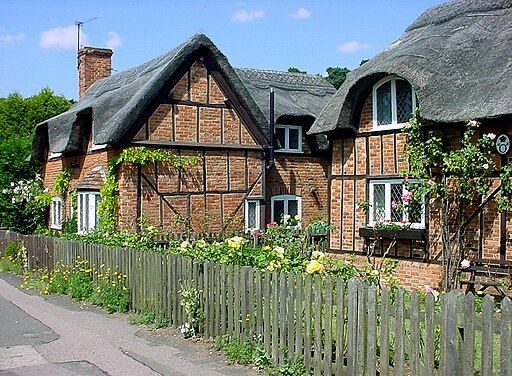Vintage British gardens have a rich history and cultural significance, dating back centuries. These gardens have been shaped by various factors, such as the influence of European gardening styles, social and economic changes, and major events like World War II. They are not only a testament to the artistry and craftsmanship of the past, but also provide a glimpse into the values and lifestyles of the people who created and enjoyed them.
Beginnings

Botanical Prints of Herbs by William Turner, Public domain, via Wikimedia Commons
The earliest known British gardens can be traced back to the Roman occupation of Britain in AD 43, where they established formal gardens for their wealthy citizens. However, it wasn't until the medieval period that gardens began to take on a more decorative role. These gardens were often enclosed by walls and were used for both practical and symbolic purposes. Many were used to grow food and medicinal plants, while others were designed to reflect religious beliefs or display wealth and status. Monastic gardens, for example, were designed to provide food for the monks and were also used for contemplation and prayer. The first recorded ornamental garden was created by King Henry VIII's physician, Dr. William Turner, in the mid-16th century. The garden was designed to showcase exotic plants and was seen as a symbol of wealth and prestige. Over time, gardens became an important part of British culture and have continued to evolve and inspire people to this day.
Capability Brown: Back to Nature

Bust of Capability Brown, MacDurk, CC BY-SA 4.0, via Wikimedia Commons
Often described as "England's Greatest Gardener", Lancelot 'Capability' Brown was revolutionary in garden design and completely turned the idea of the garden on its head. Before Capability Brown's influence, British gardens were predominantly formal, geometric, and symmetrical, often modeled after French or Dutch gardens. The gardens were designed to be viewed from above, as a piece of art, and were often embellished with topiary, fountains, and statues.
However, in the mid-18th century, Lancelot "Capability" Brown, a landscape architect, began to revolutionize British gardening by introducing a more naturalistic style. Brown believed in creating a landscape that looked like it had always been there, with rolling lawns, curving paths, and trees planted in clumps rather than straight rows.
Brown's gardens were designed to be viewed from ground level, with carefully crafted vistas and focal points that drew the viewer's eye into the distance. He was also known for his use of water features, such as lakes and rivers, to enhance the natural feel of his landscapes.
Brown's work quickly gained popularity, and by the end of the 18th century, his style had become the dominant form of British gardening. His influence can still be seen in many of the great gardens of Britain today, including Blenheim Palace, Chatsworth House, and Stowe Landscape Gardens.
For those who appreciate the distinct English charm of Capability Brown's gardens but also crave a more refined and colorful touch, the illustrious Gertrude Jekyll's style of gardening is often the perfect fit.
Gertrude Jekyll: Plant-first design

Dave_S. from Witney, England, CC BY 2.0, via Wikimedia Commons
Gertrude Jekyll was a prolific garden designer, writer, and artist who made significant contributions to the world of gardening in the late 19th and early 20th centuries. Her influence on British gardening was far-reaching and long-lasting, and her legacy continues to inspire gardeners and landscape architects to this day. Jekyll's style of gardening was heavily influenced by the Arts and Crafts movement, which emphasized a return to traditional craftsmanship and a celebration of nature. She believed that gardens should be designed to harmonize with their surroundings and to provide a sanctuary for people to escape the stresses of modern life.

The Rose Garden at Sissinghurst Castle Gardens by Bill Boaden, CC BY-SA 2.0, via Wikimedia Commons
One of Jekyll's most notable achievements was the creation of the iconic garden at Sissinghurst, which she designed in collaboration with her friend and client, Vita Sackville-West. The garden, located in Kent, is famous for its intricate design and use of color, with different areas of the garden featuring a different color scheme. Jekyll's signature style is evident in the use of planting schemes that harmonize with the surrounding landscape, as well as the use of garden rooms and carefully curated views to create a sense of intimacy and tranquility. The garden at Sissinghurst is widely regarded as one of the most beautiful gardens in England and has been the subject of numerous books and articles.

Jekyll's influence on British gardening went far beyond Sissinghurst, however. She designed gardens for many prominent clients, including Edwin Lutyens, and her articles and books on gardening were widely read and influential. In contrast to Brown's gardens, like Stowe and Blenheim, which were designed on a grand scale, with sweeping vistas and long axial views, Jekyll's approach to garden design, emphasizing simplicity, harmony, and a deep understanding of the natural world, was revolutionary at the time and helped to usher in a new era of garden design in Britain. Her legacy continues to inspire gardeners and designers around the world, and her work is celebrated in numerous gardens and public spaces throughout England.
Gardening during World War II
World War II had a significant impact on British gardens, as the need for food production and resource conservation became increasingly important. Many gardens were transformed into vegetable plots and allotments, with homeowners encouraged to grow their own produce to supplement rations and support the war effort. This movement was known as the “Dig for Victory” campaign, and it inspired many Britons to get involved in gardening for the first time.
In addition to the creation of victory gardens, the war brought about other changes in British gardening practices. The lack of resources meant that traditional garden designs were often abandoned, and gardens were transformed into functional spaces that could be used for growing crops and providing food. This led to an increased use of organic gardening methods, as chemical fertilizers and pesticides were in short supply.
Despite the hardships of wartime, many Britons found solace in their gardens and continued to nurture them as a source of beauty and respite from the chaos of war. The importance of gardening for physical and mental health was recognized by the government, which encouraged citizens to maintain their gardens as a way of boosting morale and promoting well-being. As a result, gardens became not only a practical necessity but also a symbol of hope and resilience during a difficult period in British history.
Modern Gardening: Vintage Gardens Revisited

APB-CMX at English Wikipedia, Public domain, via Wikimedia Commons
In recent years, there has been a renewed interest in vintage gardens and traditional gardening practices. One of the most popular styles is the cottage garden, which was a staple of British gardens in the 19th century. These gardens are known for their informal, romantic feel and are characterized by a mix of flowering plants, herbs, and vegetables. The emphasis is on creating a lush, naturalistic environment that is both beautiful and productive.
Another trend in vintage gardening is the move towards more sustainable and eco-friendly practices. This includes the use of organic fertilizers, the incorporation of native plants, and the creation of habitats for wildlife. Many gardeners are also turning to traditional methods of pest control, such as companion planting and crop rotation, to reduce the need for chemical pesticides.
Overall, the resurgence of vintage gardening reflects a growing interest in the history and heritage of British gardens, as well as a desire to connect with nature in a more meaningful way. Whether it's through the creation of a cottage garden or the adoption of sustainable gardening practices, vintage gardens offer a glimpse into the past while also providing inspiration for the future.
For more information on British garden design from the past to the current day, watch this entertaining BBC produced documentary presented by iconic Britsh gardener, Monty Don - 'The Secret History of the British Garden'.

